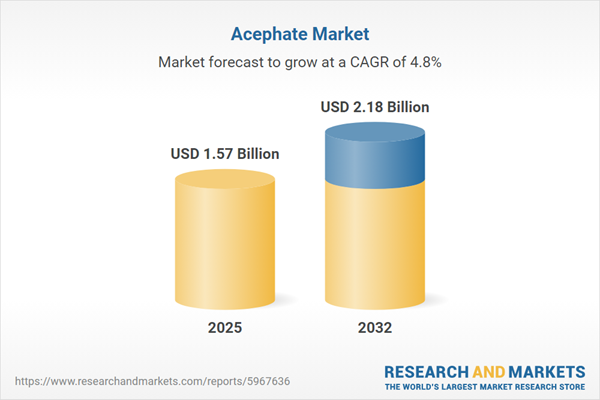Speak directly to the analyst to clarify any post sales queries you may have.
Acephate continues to shape modern agricultural pest management, offering integrated solutions for crop protection as industry stakeholders seek resilience and innovation in a regulated and competitive global landscape.
Market Snapshot: Acephate Market Growth and Trajectory
The acephate market grew from USD 1.50 billion in 2024 to USD 1.57 billion in 2025, with expectations for continued expansion at a CAGR of 4.80%, reaching USD 2.18 billion by 2032.
This trajectory highlights steady demand driven by evolving pest pressures, regulatory scrutiny, and technological advancements in formulation and application.Scope & Segmentation
This analysis provides a comprehensive view across segments, capturing both current trends and innovation areas:
- Crop Types: Cereals and grains, fruits and vegetables (including fruit bearing, leafy, and root/tuber varieties), oilseeds, pulses, ornamental plants.
- Formulation Types: Dust, emulsifiable concentrate, granule, suspension concentrate, wettable powder.
- Application Methods: Foliar spray, seed treatment, soil treatment.
- Sales Channels: Direct sales, distributor, e-commerce, retailer.
- Regions Covered: Americas (North America, Latin America), Europe, Middle East, Africa, Asia-Pacific (notably China, India, Japan, Australia, South Korea, key Southeast Asian nations).
- Analyzed Companies: Adama Ltd., UPL Limited, FMC Corporation, Nufarm Limited, Corteva, Inc., Sinochem Group Co., Ltd., Hubei Sanonda Co., Ltd., Nanjing Red Sun Co., Ltd., Shanghai Youngsun Agrochemical Co., Ltd., Jiangsu Danhe Agrochemical Co., Ltd.
Key Takeaways for Senior Decision-Makers
- Acephate's systemic action and broad-spectrum efficacy position it as a foundational component in integrated pest management, supporting stable crop yields even under diversified pest threats.
- Compliance pressures have accelerated the shift to advanced formulations, targeted application techniques, and precision agriculture tools, allowing users to achieve both efficacy and environmental stewardship.
- Market segmentation reveals differentiated adoption by crop type, with high-value fruits, vegetables, and specialty crops driving innovation in residue management and application precision.
- Supply chain resilience is increasingly important as manufacturers adjust sourcing and invest in localized production to mitigate disruptions and strengthen delivery capacity.
- Digital and data-driven platforms are supporting more responsive inventory, compliance, and application management for both distributors and growers.
- Competitive dynamics reflect a blend of multinational leadership, regional expertise, and the entry of agile startups, with ongoing alliances among chemical producers, distributors, and digital technology providers.
Tariff Impact on Acephate Supply Chains (2025)
Recent United States tariff policy revisions targeting agrochemical precursors have increased procurement costs, prompting manufacturers to diversify suppliers and invest in localized or regional production. This adaptive response is enhancing overall market resilience. Growers and distributors are addressing increased costs with more precise pest management and input optimization strategies, ensuring the reliability and competitiveness of acephate solutions.
Methodology & Data Sources
This research employs primary interviews with industry experts—including agronomists, distributors, and regulatory officials—combined with an exhaustive review of public documents, academic sources, and industry white papers. Analytical frameworks and rigorous cross-verification ensure validated and actionable insights.
Why This Report Matters
- Enables senior leaders to anticipate regulatory developments and proactively refine product portfolios and supply chain strategies.
- Provides clear visibility into market segmentation and technology trends, supporting better-targeted innovation and risk mitigation.
- Delivers a robust foundation for strategic planning, informed investment, and operational agility in a complex regulatory and demand environment.
Conclusion
With evolving regulations, complex supply chains, and technological disruption, decision-makers benefit from actionable insight into the acephate market's direction. This report supports strategic adaptation and sustained performance in global crop protection.
Additional Product Information:
- Purchase of this report includes 1 year online access with quarterly updates.
- This report can be updated on request. Please contact our Customer Experience team using the Ask a Question widget on our website.
Table of Contents
3. Executive Summary
4. Market Overview
7. Cumulative Impact of Artificial Intelligence 2025
Companies Mentioned
The companies profiled in this Acephate market report include:- Adama Ltd.
- UPL Limited
- FMC Corporation
- Nufarm Limited
- Corteva, Inc.
- Sinochem Group Co., Ltd.
- Hubei Sanonda Co., Ltd.
- Nanjing Red Sun Co., Ltd.
- Shanghai Youngsun Agrochemical Co., Ltd.
- Jiangsu Danhe Agrochemical Co., Ltd.
Table Information
| Report Attribute | Details |
|---|---|
| No. of Pages | 193 |
| Published | November 2025 |
| Forecast Period | 2025 - 2032 |
| Estimated Market Value ( USD | $ 1.57 Billion |
| Forecasted Market Value ( USD | $ 2.18 Billion |
| Compound Annual Growth Rate | 4.8% |
| Regions Covered | Global |
| No. of Companies Mentioned | 11 |









